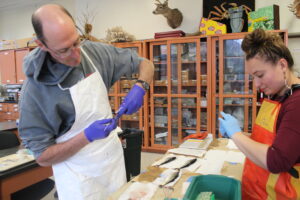
News, Research, Featured
News, Research, Featured
News, Research, Featured
Yaaw Sampling
Each spring, Yaaw, or Pacific herring (Clupea pallasi) gather in Southeast Alaska’s waters after spending the majority of their lives in the Northern Pacific Ocean. Individual fish measure around nine inches and congregate in massive schools to spawn. This migration attracts a range of predators, including humpback whales, sea lions, and humans.

Herring eggs on seaweed, spring 2025
As a keystone species in the region, Pacific herring hold deep significance for Indigenous peoples, who have relied on them for generations. Environmental changes and increases in harvesting levels have all contributed to significant reductions in the Yaaw biomass sparking concern and the need for research into their population health.

Herring spawn in front of Sage building, spring 2025
For the last 15 years, Hershberger has traveled to Sitka every spring to learn more about this impactful fish. Funded by both National Science Foundation (NSF) and the Exxon Valdez Oil Spill Trustee Council (EVOSTC) Hershberger’s research focuses on several viruses and the prevalence of Ichthyophonus, a common fish pathogen, in Yaaw populations.
“Ichthyophonus is ecologically and economically the most significant parasite of marine fish in the world.” – Paul Hershberger, Ph.D.
Hershberger’s work on Ichthyophonus helps to enhance our understanding of the parasite in other fish species as well. Ichthyophonus has been detected in Yukon salmon populations and is being studied as a potential contributing factor to mortality before spawning. Ongoing research will continue to enhance our knowledge and provide critical tools for preserving our natural resources.
Much of Hershberger’s research takes place in Washington, where he grows Yaaw from eggs to adults at the Marrowstone Marine Field Station. In the lab, Hershberger can closely study virus and parasitic infections of individuals and groups. This data serves to expand our knowledge of the species and better understand stresses on populations.
Over two days of fieldwork, Hershberger and Zofia Danielson, SSSC Research Coordinator, collected tissue and blood samples from 136 individual herring from Sitka Sound. These samples will be analyzed to assess the prevalence and severity of Ichthyophonus and common viruses, VHS, and VEN in the herring population returning to Sitka this year.

Paul Hershberger, Ph.D. and Zofia Danielson collecting samples
Samples collected in Sitka serve as a reference batch for Hersberger’s investigation into Yaaw population health in Prince William Sound. Many are familiar with the catastrophic Exxon Valdez tanker spill 36 years ago, releasing 11 million gallons of crude oil into pristine wilderness. The aftermath was devastating, and recovery efforts continue today. Hershberger’s research over the past 15 years has focused on understanding Pacific herring health in the post-spill Prince William Sound ecosystem.
Thanks to ongoing research funding from EVOSTC and NSF, Hershberger will continue his study of Yaaw for the coming years. Supported by NSF, he is investigating how diseases are adapting to climate change and what the future might look like for large fish populations; helping us better understand and safeguard our natural resources.
Further reading
– https://evostc.state.ak.us/restoration-projects/herring-research-and-monitoring-program/
